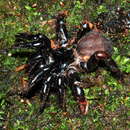pt-BR
nomes no trilho de navegação


Actinopus is a genus of mygalomorph spiders in the family Actinopodidae. It was first described by Josef Anton Maximilian Perty in 1833 from the type species Actinopus tarsalis found in Brazil.[5][6] The name is derived from Greek actin- "ray, beam" and pous "foot".[5] It is a senior synonym of Aussereria, Closterochilus, Pachyloscelis, and Theragretes.[2][3][4]
The few reported bites from Brazil resulted in no symptoms, indicating that they can deliver dry bites or small amounts of venom.[7] However, they should be treated with caution due to some reports of bites causing local pain and muscle contractions.[8] These spider also have a low venom yield, Actinopus crassipes for example has a mean venom yield of 0.09 mg.[9]
As of January 2023 it contains 97 species:[1]
Formerly included:
Actinopus is a genus of mygalomorph spiders in the family Actinopodidae. It was first described by Josef Anton Maximilian Perty in 1833 from the type species Actinopus tarsalis found in Brazil. The name is derived from Greek actin- "ray, beam" and pous "foot". It is a senior synonym of Aussereria, Closterochilus, Pachyloscelis, and Theragretes.
The few reported bites from Brazil resulted in no symptoms, indicating that they can deliver dry bites or small amounts of venom. However, they should be treated with caution due to some reports of bites causing local pain and muscle contractions. These spider also have a low venom yield, Actinopus crassipes for example has a mean venom yield of 0.09 mg.